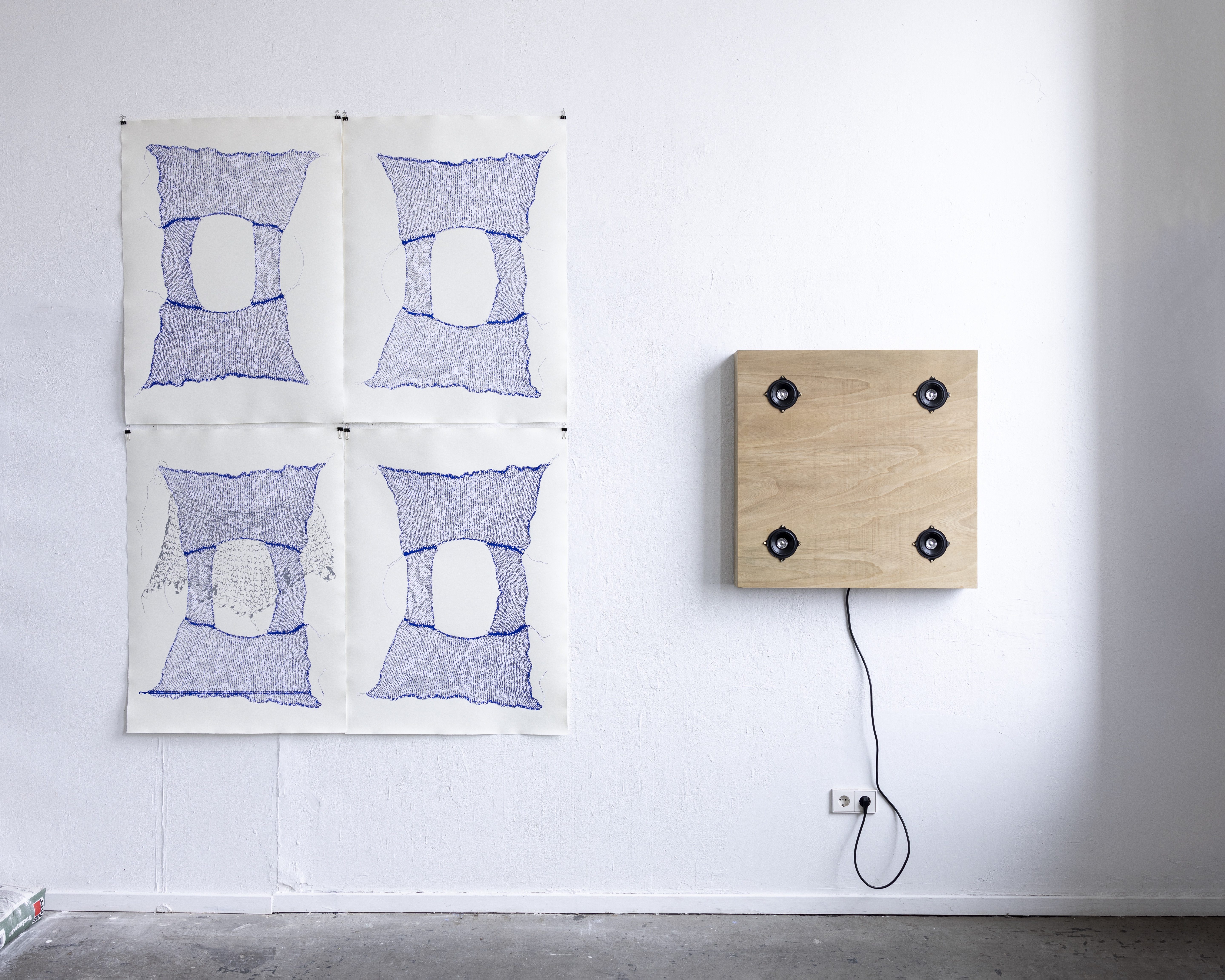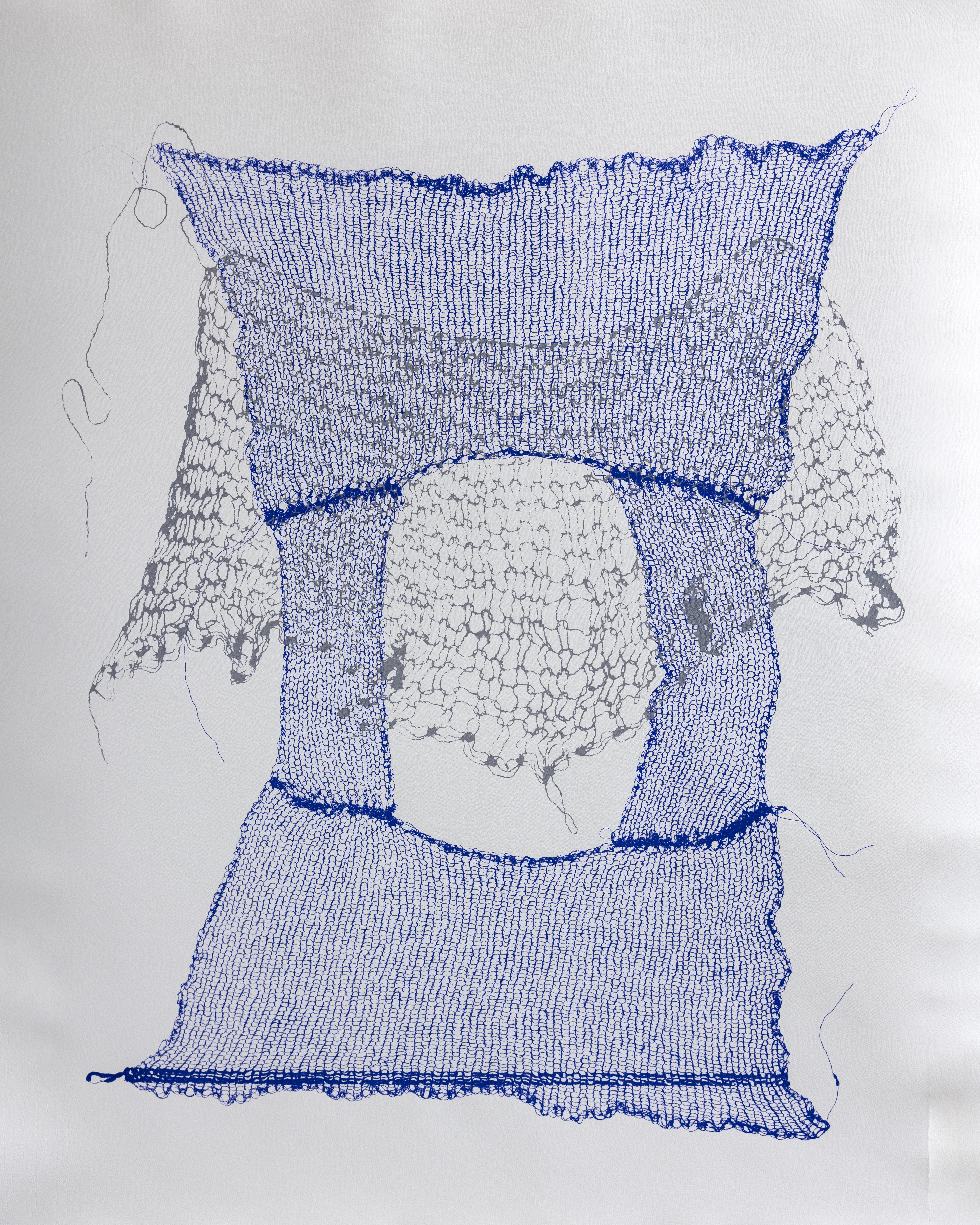






Needle, Number, Dolphin, Wave, 2024
Ming Yuan
pine wood, speakers, cables
100 x 100 x 10 cm, 14 minutes
Piece for Four Synths, 2023
Ming Yuan
silkscreen on paper
280 x 200 cm
Ming Yuan
pine wood, speakers, cables
100 x 100 x 10 cm, 14 minutes
Piece for Four Synths, 2023
Ming Yuan
silkscreen on paper
280 x 200 cm
ABOUT THE WORK
Using metal knitting needles attached to a computer, the artist improvised a mohair yarn panel and generated the four-channel sound piece. The rhythms and movements of her body during knitting are translated into sonic languages as well as visual language, exploring the sphere of pattern, order, and aesthetics.
The noise of two stainless steel spinning needles bumping/sliding against each other and the friction noise of mohair yarn rubbing against the needles are recorded. Meanwhile, the spinning needles are pre-soldered to a cable that connects to an Arduino controller, which translates the motion of the artist's weaving into a series of voltage-strength changes that are sent to a computer, where they are broken down into electrical signals. These signals are transformed through an artist-designed Max Msp patch that controls the content, rhythm, and volume of the playing samples.
The knitted panel is constructed with white mohair yarns and simple stitching techniques, suggesting to the viewer to notice the rhythm of repetition, which corresponds to human-controllable opportunities and human-uncontrollable (probabilistic quantum physics-like) Chance. The speakers loop the sounds collected and processed during the performance, creating a unique soundscape sound environment. The aesthetic premise of the sound samples in the installation is minimalist, futuristic, schematic, and experimental. Through symmetry and fine details, the aesthetic presumes that the concept of "repetition" of human and machine that the work focuses on can be conveyed. In this performance, various different methods of collecting, producing, and processing sound allow for vocal and synthetic samples, human-controlled and machine-controlled rhythms, geometric arrangements, and random collisions and balances of machines.
The knitted panel is then placed between a sheet of glass and the silkscreen plate for exposure in UV light. The photosensitive layer painted on the silkscreen allows the lights to precisely picture every detail from the knitted garment, transferring the original shape and haptics of the fabric into a two-dimensional image. The process of exact image transfer from an object into an image not only creates a portrait of the muted panel, which is considered by the artist a graphic score for the sound piece, but also it is an experimentation to transform something ephemeral and fragile into something more robust and rather eternal. The artist has always worked with yarn as a sculptural material, and despite its beautiful and complex visual impression, the material is very fragile and might collect clusters of dust and deteriorate over time. In order to preserve the beautiful characteristics of the material and at the same time combat the fragility of it, the artist came up with silk screen as a technique to make some yarn evolve into a durable material. With the vibrant blue color printed on handmade paper, a feeling of delicacy and detail is immediately conveyed, similar to watching a piece of real knitted mohair garment.
Throughout her practice, graphic scores have always been an interesting source of inspiration. Interested in translating information and messages between different media, the artist has tried to visualize sound blinds, shapes, and colors. In this work, she translates her body language into binary computational language, and then into sonic languages, giving birth to the speaker piece and creating a unique soundscape. The sound piece is then manifested or translated into the graphic score, which is the knitting pattern that induced sound itself. This work, the cost, is the translation, and the translated were all encapsulated into materials and presented as visual and sonic languages. It is an experiment and an attempt to explore idioms and their borders.
There's something similar between knitting, music, and time. The one-directionality and the compose system signets unique features to read into them. Why read a score from left to right and from top to bottom, and there is a continuity between every remark. The notes shall be read in relation to other notes and changes must be made not singularly but collectively. Everyone plays OneNote wrong; one must go back to that note and complete the paragraph as a whole again. This applies to knitting patterns; one must go all the way back and take down the already knitted parts in order to redo the singular point in the middle. Another interesting perspective that connects them all is about repetition and uniqueness. Every note is marked as it is and does not change its appearance on the score. However, every time the musician plays this note on the piano, for example, it all sounds different, and no single note is identical to another. Knitting, also on the knitting pattern, the same stage is marked; in reality, no stage is the same, depending on the tension, the yarn, and the way the person knits it. A singular unit in a big collective system is only theoretically possibly identical.
Using metal knitting needles attached to a computer, the artist improvised a mohair yarn panel and generated the four-channel sound piece. The rhythms and movements of her body during knitting are translated into sonic languages as well as visual language, exploring the sphere of pattern, order, and aesthetics.
The noise of two stainless steel spinning needles bumping/sliding against each other and the friction noise of mohair yarn rubbing against the needles are recorded. Meanwhile, the spinning needles are pre-soldered to a cable that connects to an Arduino controller, which translates the motion of the artist's weaving into a series of voltage-strength changes that are sent to a computer, where they are broken down into electrical signals. These signals are transformed through an artist-designed Max Msp patch that controls the content, rhythm, and volume of the playing samples.
The knitted panel is constructed with white mohair yarns and simple stitching techniques, suggesting to the viewer to notice the rhythm of repetition, which corresponds to human-controllable opportunities and human-uncontrollable (probabilistic quantum physics-like) Chance. The speakers loop the sounds collected and processed during the performance, creating a unique soundscape sound environment. The aesthetic premise of the sound samples in the installation is minimalist, futuristic, schematic, and experimental. Through symmetry and fine details, the aesthetic presumes that the concept of "repetition" of human and machine that the work focuses on can be conveyed. In this performance, various different methods of collecting, producing, and processing sound allow for vocal and synthetic samples, human-controlled and machine-controlled rhythms, geometric arrangements, and random collisions and balances of machines.
The knitted panel is then placed between a sheet of glass and the silkscreen plate for exposure in UV light. The photosensitive layer painted on the silkscreen allows the lights to precisely picture every detail from the knitted garment, transferring the original shape and haptics of the fabric into a two-dimensional image. The process of exact image transfer from an object into an image not only creates a portrait of the muted panel, which is considered by the artist a graphic score for the sound piece, but also it is an experimentation to transform something ephemeral and fragile into something more robust and rather eternal. The artist has always worked with yarn as a sculptural material, and despite its beautiful and complex visual impression, the material is very fragile and might collect clusters of dust and deteriorate over time. In order to preserve the beautiful characteristics of the material and at the same time combat the fragility of it, the artist came up with silk screen as a technique to make some yarn evolve into a durable material. With the vibrant blue color printed on handmade paper, a feeling of delicacy and detail is immediately conveyed, similar to watching a piece of real knitted mohair garment.
Throughout her practice, graphic scores have always been an interesting source of inspiration. Interested in translating information and messages between different media, the artist has tried to visualize sound blinds, shapes, and colors. In this work, she translates her body language into binary computational language, and then into sonic languages, giving birth to the speaker piece and creating a unique soundscape. The sound piece is then manifested or translated into the graphic score, which is the knitting pattern that induced sound itself. This work, the cost, is the translation, and the translated were all encapsulated into materials and presented as visual and sonic languages. It is an experiment and an attempt to explore idioms and their borders.
There's something similar between knitting, music, and time. The one-directionality and the compose system signets unique features to read into them. Why read a score from left to right and from top to bottom, and there is a continuity between every remark. The notes shall be read in relation to other notes and changes must be made not singularly but collectively. Everyone plays OneNote wrong; one must go back to that note and complete the paragraph as a whole again. This applies to knitting patterns; one must go all the way back and take down the already knitted parts in order to redo the singular point in the middle. Another interesting perspective that connects them all is about repetition and uniqueness. Every note is marked as it is and does not change its appearance on the score. However, every time the musician plays this note on the piano, for example, it all sounds different, and no single note is identical to another. Knitting, also on the knitting pattern, the same stage is marked; in reality, no stage is the same, depending on the tension, the yarn, and the way the person knits it. A singular unit in a big collective system is only theoretically possibly identical.